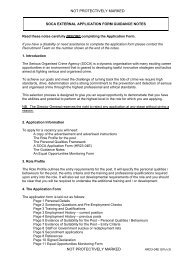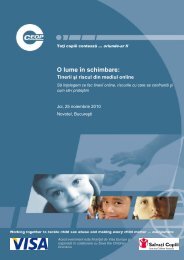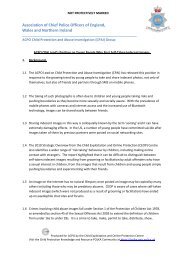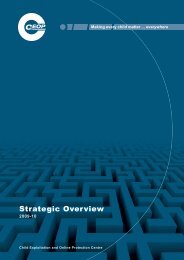Threat Assessment of Child Sexual Exploitation and Abuse - Ceop
Threat Assessment of Child Sexual Exploitation and Abuse - Ceop
Threat Assessment of Child Sexual Exploitation and Abuse - Ceop
Create successful ePaper yourself
Turn your PDF publications into a flip-book with our unique Google optimized e-Paper software.
<strong>Threat</strong> <strong>Assessment</strong> <strong>of</strong> <strong>Child</strong> <strong>Sexual</strong> <strong>Exploitation</strong> <strong>and</strong> <strong>Abuse</strong> 2013<br />
Key threat 3: Transnational child sexual abuse<br />
56. Those UK nationals who sexually abuse or exploit children overseas are frequently denoted by the term ‘Travelling Sex<br />
Offender’ (TSO). Although widely used across the global child protection community, the term may be misleading on two<br />
counts. Firstly the use <strong>of</strong> the term infers travel as a key component <strong>of</strong> the <strong>of</strong>fending. This is inaccurate as some <strong>of</strong> the most<br />
prolific <strong>of</strong>fenders <strong>of</strong>ten permanently reside overseas.<br />
57. Secondly the term can appear to suggest that the threat is from Registered Sex Offenders (RSO) who travel. Historically this<br />
has led to a disproportionate focus on the threat from RSOs who travel overseas. Reporting suggests that RSOs represent<br />
a small minority <strong>of</strong> those UK nationals who commit sexual crimes against children overseas.<br />
58. For the purposes <strong>of</strong> the TACSEA, the term ‘Transnational <strong>Child</strong> Sex Offender’, or TCSO, will be used to emphasise the specific<br />
threat to children outside <strong>of</strong> the UK.<br />
59. Research undertaken by CEOP suggests that overseas child sexual exploitation <strong>and</strong> abuse perpetrated by TCSOs can be<br />
described using a framework <strong>of</strong> characteristics, including the <strong>of</strong>fending type as described in the table below:<br />
Transnational Offending Type<br />
TRANSIENT<br />
This describes overseas <strong>of</strong>fending which is not the result<br />
<strong>of</strong> an extended grooming process. It may be facilitated<br />
by the commercial sexual exploitation <strong>of</strong> children or by<br />
country conditions <strong>and</strong> vulnerabilities which facilitate the<br />
transactional exploitation <strong>of</strong> children 14 . Transient <strong>of</strong>fending<br />
is generally perpetrated against a child or children for a<br />
short time, although it may be prolific. Some overseas<br />
residents will perpetrate transient <strong>of</strong>fending.<br />
Though the transient <strong>of</strong>fending <strong>of</strong> an individual will not<br />
be perpetrated against the same child or children for a<br />
prolonged period, those exploited in the commercial sex<br />
industry are exposed to perpetual <strong>and</strong> prolonged abuse<br />
by multiple abusers. A transient <strong>of</strong>fender is perpetuating<br />
this continual abuse, although he or she may only be<br />
personally responsible for a small part <strong>of</strong> it.<br />
EMBEDDED<br />
Embedded overseas <strong>of</strong>fending is that which is repeatedly<br />
perpetrated against the same child or children as the<br />
result <strong>of</strong> an extended grooming process. This may<br />
include the grooming <strong>of</strong> significant others <strong>and</strong> the<br />
community as well as the victim. Perpetrators are more<br />
likely to be permanently or semi-permanently residing<br />
overseas, although not exclusively.<br />
Individuals who embed themselves in local society to gain<br />
access to <strong>and</strong> abuse children pose a threat to children<br />
that is distinct from that posed by transient TCSOs.<br />
CEOP assesses the sexual abuse perpetrated by resident<br />
TCSOs is likely to be prolonged, extensive <strong>and</strong> prolific.<br />
Such abuse is associated with poorer outcomes for child<br />
victims 15 .<br />
60. It is important, however, not to label the <strong>of</strong>fender as ‘transient’ or ‘embedded’ because <strong>of</strong>fending behaviour should be seen<br />
as a potential continuum, whereby an individual may begin <strong>of</strong>fending transiently then move into embedded <strong>of</strong>fending, or<br />
vice-versa.<br />
TCSO <strong>of</strong>fending in 2012<br />
61. A total <strong>of</strong> 104 UK nationals convicted or suspected <strong>of</strong> committing sexual crimes against children overseas were reported to<br />
CEOP in 2012 16 . Following arrests overseas for child sex <strong>of</strong>fences, 79 individuals sought British Embassy consular assistance.<br />
This is a notable increase from the 2011 total <strong>of</strong> 66, which is largely attributable to a rise in requests for consular assistance in<br />
the USA <strong>and</strong> Canada.<br />
14<br />
14<br />
Where a child receives a non-cash commodity in return for sexual activity, for example food or clothing.<br />
15<br />
Mian, M., Marton, P. & LeBaron, D. ‘The Effects <strong>of</strong> <strong>Sexual</strong> <strong>Abuse</strong> on 3-5 Year Old Girls’, <strong>Child</strong> <strong>Abuse</strong> & Neglect, 8 (1996), 731-745, <strong>and</strong> Kendall-Tackett, K.A., Williams, L.M & Finkelhor, D.<br />
‘Impact <strong>of</strong> <strong>Sexual</strong> <strong>Abuse</strong> on <strong>Child</strong>ren: A Review & Synthesis <strong>of</strong> Recent Empirical Studies’, Psychological Bulletin, 113 (1993), 164-180.<br />
16<br />
Comprising 64 convictions, 20 arrests, 14 suspects, <strong>and</strong> 5 where this information is not known. Data source CEOP intelligence <strong>and</strong> overseas conviction data provided by ACPO Criminal<br />
Records Office (ACRO).











